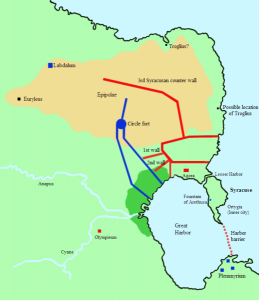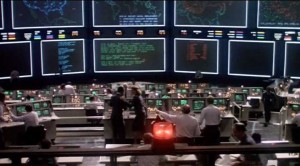
From The Jaws of Victory
In the Peloponnesian War, the 414 BC final battle of Epipole showed the pitfalls of an over-reliance on communications and single circuits. During this last battle of the Athenian siege of Syracuse, the Syracusans countered the attempt of Athens to wall in the city by building a counter-wall in the projected path of Athen’s efforts. The Syracusans had gained a critical blocking position, and Athenian General Demosthenes concocted a plan to dislodge the defenders. The Athenian forces stalled during the daytime battles outside the counter-wall, when their enemies could easily observe and rally against them, so General Demosthenes planned t strike the counter-wall at night. The well-organized nighttime Athenian attack completely overwhelmed and nearly destroyed the first Syracusan garrison. As the alarm sounded, the Athenians rushed forward without allowing themselves time to re-organize and re-identify. When the first real resistance was met, the ensuing disaster captured by Thucydides is worth citing in full:

“Although there was a bright moon they saw each other only as men do by moonlight, that is to say, they could distinguish the form of the body, but could not tell for certain whether it was a friend or an enemy. Both had great numbers of heavy infantry moving about in a small space. Some of the Athenians were already defeated, while others were coming up yet unconquered for their first attack. A large part also of the rest of their forces either had only just got up, or were still ascending, so that they did not know which way to march. Owing to the rout that had taken place all in front was now in confusion, and the noise made it difficult to distinguish anything. The victorious Syracusans and allies were cheering each other on with loud cries, by night the only possible means of communication, and meanwhile receiving all who came against them; while the Athenians were seeking for one another, taking all in front of them for enemies, even although they might be some of their now flying friends; and by constantly asking for the watchword, which was their only means of recognition, not only caused great confusion among themselves by asking all at once, but also made it known to the enemy, whose own they did not so readily discover, as the Syracusans were victorious and not scattered, and thus less easily mistaken. The result was that if the Athenians fell in with a party of the enemy that was weaker than they, it escaped them through knowing their watchword; while if they themselves failed to answer they were put to the sword. But what hurt them as much, or indeed more than anything else, was the singing of the paean, from the perplexity which it caused by being nearly the same on either side; the Argives and Corcyraeans and any other Dorian peoples in the army, struck terror into the Athenians whenever they raised their paean, no less than did the enemy.”
The solution to the communication weakness is to stay ahead of the offense-defense struggle through aggressive capital investment and streamlined lines of communication. As with the use of setting AEGIS doctrine to auto-respond to anti-ship missile (ASM) threats, cyber-warfare is far too fast for human operators. Our virtual-defense infrastructure may be significant, but it is slow, human, and defending far too many unnecessary and redundant communications. A response is a smarter investment in cyber-defense capital and a more disciplined use of our vital communications networks.

Streamlining comes from bringing all communications under control, or more accurately bringing under control those using them. We are the Athenians screaming our watch-word at one another because no one bothered to re-organize before charging in. It boils down to paying attention and staying calm; what we have is seventeen sources pinging a ship for the same information that is held in 8 PowerPoint trackers, 2 messages, at least one call over the voice circuits, and 30 emails with at least half the lazy people asking for the information in the CC line. The sheer bandwidth of material that needs protection and monitoring could be decreased with a “ctrl-f” search of email and message traffic. It also leaves a veritable treasure-trove of information lying around in hundreds of different locations, making it easier to steal or detect. Better training – not only in proper communications procedures/methods, but basic computer literacy, – could solve this problem.

The speed of cyber-attacks only allows the “labor” side of the equation to be reactive; capital investment would concentrate more money in autonomous and innovative defensive programs: 10th Fleet’s AEGIS. Proactive patrol and detection can be done with greater advances in adaptive self-modifying programs and programs that can learn or understand context. Recent developments in computing systems point to more organic systems that can”live” in the systems they defend. Biological processors and organic computing allow for hardware that thinks and learns independently, potentially giving defensive networks the added advantage of an instinct and suspicion. The development of mutable indium antimonide magnetic processors mean that the circuit hardware of a device may now be as mutable as the software running it. Imagine the vast new horizons in the OODA loop of defensive cyber systems with hubs sporting the defensive animal instinct and the ability to re-wire their own hardware. The image painted is dramatic and far-off, but modest investment and staged introduction would serve as a better model than the dangerous possibility of a “human wave” mode of thinking. With better fluid cyber-defense systems guarding more disciplined communicators, the U.S. Navy can guard its forces against Epipolaes.
Matt Hipple is a surface warfare officer in the U.S. Navy. The opinions and views expressed in this post are his alone and are presented in his personal capacity. They do not necessarily represent the views of U.S. Department of Defense or the U.S. Navy.

I don’t know that I’d say modern comms present an “even greater” challenge for IFF than historically (as your own example of the Athenians showed), but ceratinly they still present the challenge – perphaps just a different form of it, since modern technology can also be used to help IFF processes that were un available in the past.
I agree with the your arguments about communications overload, however, and such forms of communication might make for a new focus of emissions control (EMCON). But it’s primarily a command and control (C2) issue. Throwing money at cyber defense is a broad and vague prescription, which you initially seemed to do, so I’m glad you highlighted some of the more interesting, and as you state “far-off”, adaptive approaches for potential seed money.
On a related note, intriguing findings from a U.S. Defense Science Board report about cyberattacks. According to the Christian Science Monitor, “The task force also advises keeping some crucial forces offline, to respond in the event of a catastrophic cyberattack, à la “Battlestar Galactica.””
The important distinction here is that you’d be able to keep forces free from the potential of sabotage exploiting network/cyber vulnerabilities, as opposed to keep forces networks’ intact. Thus you’d have a reserve able to fight with limited or no comms, rather than all of your forces rendered unable to fight in the event of that cyber sabotage.
I’m just saying that the level of complication is much higher, as are the potential points of failure.
I do like the idea of keeping some forces “off the net”, but how would one do that? Are we talking, like when PC’s are in the shipyard, how we all use personal laptops? Would we just carry a redundant system off-line that occasionally has updates pushed to it? It’s an interesting concept, but I do think the better option would be a network able to actively defend itself. That way, you could keep finding flaws/updating/changing as necessary. Anyone who has used a ship’s LAN understands how each one is painfully different and difficult for its users. I wouldn’t want to go into combat with a network that hadn’t been used for 6 months. Maybe a cycle? Ships inport use commercial networks unless absolutely necessary? You could kill message traffic, use email alone for low-side work, and use high-side voice circuits. It would cut down on useless chatter as well as keep down on points-of-contact for the network to be attacked.